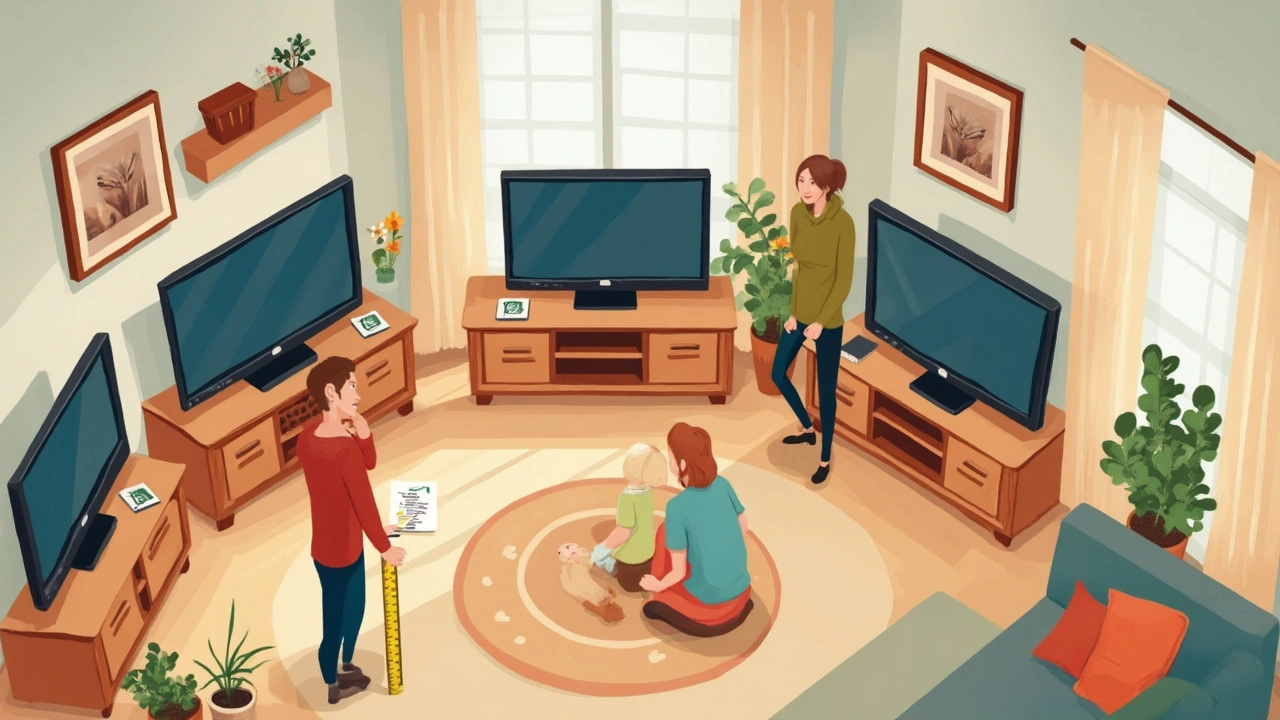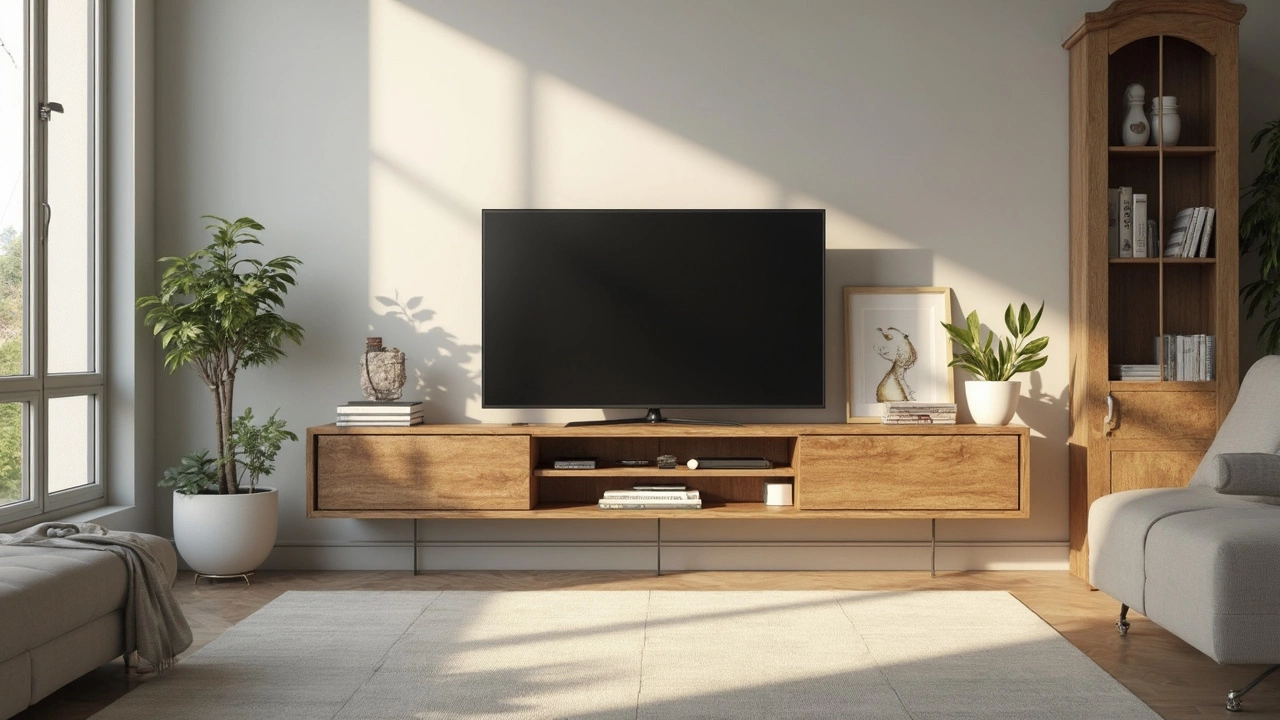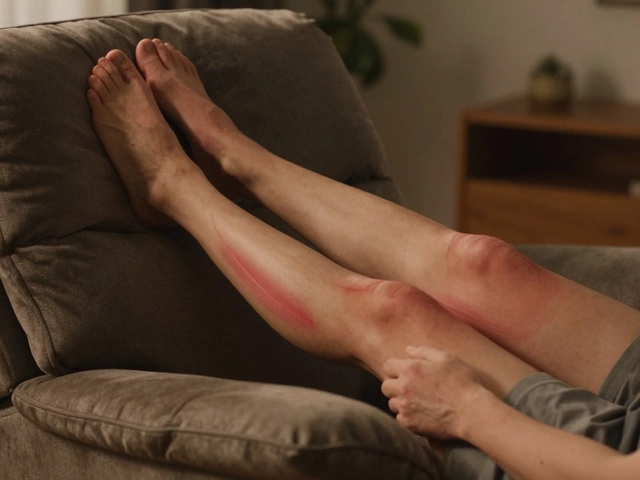Buying a TV is fun until you realize your stand is either too short, too long, or just plain awkward. The truth is, the length of your TV stand makes a big difference. It affects not just how your living room looks, but how easy it is to watch TV, toss a remote down, or keep your speaker safe from falling off an edge.
So, how much longer should the stand be than the TV? People often eyeball it, but that's risky—one little miscalculation and you’ll be stuck with a setup you hate looking at every day. There’s actually a simple sweet spot most folks agree on, and you don’t need to be a designer to nail it.
If you measure right, you’ll avoid your flat-screen hanging off the edges or looking lost on a massive piece of furniture. Not to mention, you’ll give yourself space for stuff like game consoles, soundbars, or the ever-growing pile of TV remotes (they multiply, I swear). It’s not just about making things look neat; it can stop accidents if you have kids, pets, or friends who get a bit too excited during movie night. Max, my golden retriever, once knocked a remote right off the edge—if the stand had been shorter, that remote would’ve been toast.
- Why TV Stand Length Matters
- The Ideal Size Difference
- Real-Life Sizing Examples
- Extra Benefits of Enough Overhang
- Mistakes to Dodge When Picking a Stand
Why TV Stand Length Matters
If you think TV stand length is just about the look, think again. The right length directly affects your TV’s stability, the safety of your gear, and how you use your living room. Your TV should sit in the middle of the stand, and the base needs to fully support it. When the stand is too short, your TV can tip over more easily—especially if you have little kids or a dog like Max racing around. Even a small bump could send a big-screen tumbling.
There’s another angle people miss: space for accessories. Modern setups aren’t just a TV on a table. Think about streaming boxes, speakers, chargers, and all those remotes. You want enough surface area to keep these things nearby without crowding the screen or making it look messy.
If you get the TV stand length right, you’re also protecting your walls. A TV stand that’s too short might leave your screen hanging off the edge or pushed up against the wall, which can scratch paint or mess with the cables. A too-long stand sucks up floor space, making your room feel tighter than it is.
| TV Size (inches) | Recommended Stand Length (inches) |
|---|---|
| 43 | 50-55 |
| 55 | 60-65 |
| 65 | 70-75 |
| 75 | 80-85 |
Check out the numbers in the table. A stand a few inches longer than your TV on each side gives things balance and stops accidents. It also makes the whole setup look intentional, not like you crammed a huge TV onto a tiny shelf or lost a small TV in a sea of empty wood.
When picking a stand, think about who’s using the room. Do you have kids? Pets? Party guests? The right size keeps everyone (and everything) safe. Plus, a good fit just feels right when you’re watching your favorite show or hosting a group movie night.
The Ideal Size Difference
Figuring out how much longer your TV stand should be than your TV doesn’t have to feel like a guessing game. People in the know usually recommend making your stand at least 6-12 inches longer than your TV. This means if you have a 55-inch TV (and remember, that’s the diagonal size, not the width), you should check the actual width in inches and add 3 to 6 inches on each side. That extra space keeps things balanced and safe, and it just plain looks better.
For quick reference, here’s a handy table of common TV sizes and the minimum recommended stand length for each:
| TV Size (Diagonal) | Average TV Width (inches) | Minimum Stand Length (inches) |
|---|---|---|
| 43" | 38" | 44" |
| 50" | 44" | 50" |
| 55" | 48" | 54" |
| 65" | 57" | 63" |
| 75" | 66" | 72" |
It’s easy to get thrown by the whole diagonal-vs-width thing, so definitely check your TV’s width (it’ll be in the specs or you can measure it). As a rule, don’t pick a stand that’s shorter than your screen width, unless you actually want your TV hanging off the sides. That’s not just awkward; it can be risky if folks or pets bump into it.
To recap, your goal is for the stand to be wider than the TV—ideally by about 3 to 6 inches on each side. It frames your TV, leaves space for speakers or decorations, and just feels more put-together. If you’re tight on space, the minimum is for the TV stand length to match or slightly exceed your TV’s actual width. Anything less and you’re asking for stress.
- Measure your TV’s width (not the diagonal).
- Add at least 6 to 12 inches total (3 to 6 inches on each side).
- Pick a stand that fits your space—even if it means scooting a sofa or clearing some old DVDs.

Real-Life Sizing Examples
Let’s break down some numbers, because guessing isn’t the way to go. The golden rule is to have your TV stand at least 6 inches longer on both sides than your TV. That means if your TV is 55 inches wide, your stand should be around 67 inches long—leaving you with a neat overhang of six inches on each side.
If you want a simple formula, here it is: TV stand length = TV width + 12 inches. This makes shopping way easier.
| TV Size (Diagonal) | TV Width (approx.) | Recommended Stand Length |
|---|---|---|
| 43" | 38" | 50" |
| 50" | 44" | 56" |
| 55" | 48" | 60" |
| 65" | 57" | 69" |
Sure, sometimes your space or furniture options don’t match up perfectly. If you’re crunched for room, always make sure the stand is at least as wide as the TV—never less. Anything narrower is just asking for disaster, especially if you’ve got dogs or kids who love to zoom around the living room. Bigger is actually better, but don’t go wild. A 75" stand for a 32" TV looks odd and swallows up your space. Balance is the name of the game.
And here’s a heads-up—TV sizes are listed by diagonal, but stand lengths and TV widths are measured straight across, so check your TV’s actual width with a tape measure, not just the box label. This step saves you the hassle of returns and re-assembly. Check product listings for the “TV width” or grab that measuring tape and double-check it yourself.
- For a 50-inch TV (about 44-inch wide): look for a 56-inch stand.
- Got a 65-inch TV (about 57-inch wide)? A 69-inch or longer stand is your target.
- Running tight on space with a 43-inch TV (about 38-inch wide)? A 50-inch stand is your sweet spot.
Stick with these numbers and picking the right TV stand length gets a whole lot simpler. It’s a practical home upgrade that’ll keep your claws (and Max’s tail) out of trouble.
Extra Benefits of Enough Overhang
Making sure your TV stand sticks out past the edges of your TV—it’s not just about looks. Having that extra overhang comes with a bunch of real perks, and it’s something that often gets overlooked.
First up, let’s talk about protecting your stuff. If your TV is close to the edge, a small nudge is all it takes for things—like remotes, controllers, or even speakers—to take a dive. With enough overhang, you’ve got a safety net. I can't count how many times Max’s wagging tail has sent a remote flying. That little bit of extra space makes a surprising difference, especially in homes with pets or small kids.
Another big plus is room for your gear. Most people have more than just a TV on their stand: soundbars, game consoles, streaming boxes, Wi-Fi routers—you name it. A longer TV stand gives you actual space to keep these organized and stops your setup from turning into a cluttered mess. And hey, if you ever want to display a few photos or stick a plant for a touch of green, you’ve got the room to do it without crowding your screen.
There’s also the cleaning angle. Dust is way less likely to pile up around (and behind) your TV if you can easily reach around it. No more weird puddles of dust you pretend you can’t see.
If you’re the type to change things up, even occasionally, you’ll love the flexibility. That overhang lets you adjust the positioning of your TV or add more devices in the future without needing a whole new stand. It’s future-proofing, basically—a small detail that keeps on paying off down the line.
- Prevents accidental falls of tech or décor
- Keeps wires and accessories tidy
- Makes cleaning easier
- Gives better separation between TV and speakers (reduces audio muddiness)
Here’s a quick look at the happy medium for TV stand length compared to TV sizes:
| TV Size (inches) | Recommended Stand Overhang Each Side (inches) | Total Stand Length (inches) |
|---|---|---|
| 50" | 3 - 6 | 56 - 62 |
| 60" | 3 - 6 | 66 - 72 |
| 75" | 3 - 6 | 81 - 87 |
Even retail furniture brands often suggest that your stand should be at least 6 inches longer than your TV, which basically means 3 inches sticking out on each side. It’s a pretty simple trick, but it makes your whole setup safer, neater, and a lot easier to live with.

Mistakes to Dodge When Picking a Stand
Most people think every stand is just a big flat board with legs, but there's more to it—and it’s easy to mess up. Picking the wrong stand isn’t just about looks; it can mess with your space, cause clutter, or make movie night more frustrating than it should be. Here are the mistakes folks make all the time and how to steer clear of them.
- TV stand length that’s too short or too long: If your stand is shorter than the TV, that’s just asking for trouble. Edges will stick out, raising the chance of someone bumping it or, worse, knocking it over. On the flip side, if it’s way too long, your setup might look out of balance, like a tiny island in a sea of furniture.
- Mixing up width and length: TV measurements are diagonal, but stands are measured straight across. Don’t make the popular mistake of comparing the TV’s diagonal size to the stand’s width. Your 55-inch TV isn’t 55 inches wide. Most 55-inch TVs are about 48 inches across, give or take, depending on the frame (bezel).
- Forgetting about extra gear and cables: Consoles, soundbars, cable boxes—they all need their own space. If you don’t count them in, your stand will end up a mess of tangled wires and stuff crammed anywhere it fits.
- Ignoring weight limit: Some stands, especially budget ones, can’t handle big TVs. Always check the specs! A stand with a 70-pound weight limit shouldn’t hold a 75-pound TV, no matter what the sales guy says. This is how TVs end up crashing to the ground.
- Skipping wall space and viewing height: A stand shouldn’t just fit the TV, it needs to suit the room. If you don’t measure out the wall area, you might buy a stand that blocks outlets, vents, or windows. Also, your screen should sit at eye level from your couch, not way above your head or below your knees.
Here’s how these mistakes stack up in real life:
| Mistake | What Happens | How Often Reported |
|---|---|---|
| Stand too short for TV | TV hangs off edges, safety risk | High (1 in 5 buyers regret this) |
| Used TV diagonal as width | Stand doesn’t fit TV properly | Very common on first-time purchases |
| Didn’t check weight rating | Stand sags or breaks | Medium (usually with larger TVs) |
| No space for devices | Messy, stuff stacked awkwardly | Frequent, especially with gamers |
Measure everything out before buying. Seriously—get a tape measure, size up your gear, and lay it out on the floor with masking tape if you need to. If you’re shopping online, double-check the stand’s specs—they’re there for a reason. Missing any of these steps can leave you stuck with a stand that’s a pain to use or worse, a safety hazard in your living room. I learned that the hard way after not factoring in speaker space—ended up with cables everywhere and Serena was not thrilled.







